The multi-age classroom is more than a trend—it’s a solution to the growing need for inclusive, flexible learning environments in preschools and daycares. Instead of dividing children strictly by age, these classrooms group kids by readiness, interest, and social development. The result? Older children develop leadership skills, younger children learn through peer modeling, and everyone gains from a collaborative, real-world learning experience.
But creating a successful multi-age classroom doesn’t happen by accident. It requires thoughtful planning, a deep understanding of how different age groups interact, and design choices that promote autonomy, creativity, and safety. Every piece of furniture, every shelf, and every corner needs to work for more than one age and adapt as children grow.
In this comprehensive guide, you’ll find detailed, practical strategies for setting up a multi-age classroom that works. We’ll explore classroom layout, furniture choices, activity zoning, storage solutions, and behavior-friendly design while keeping your real-world constraints in mind. Whether you’re starting from scratch or optimizing your current space, these tips will help you create a classroom that supports every child daily.
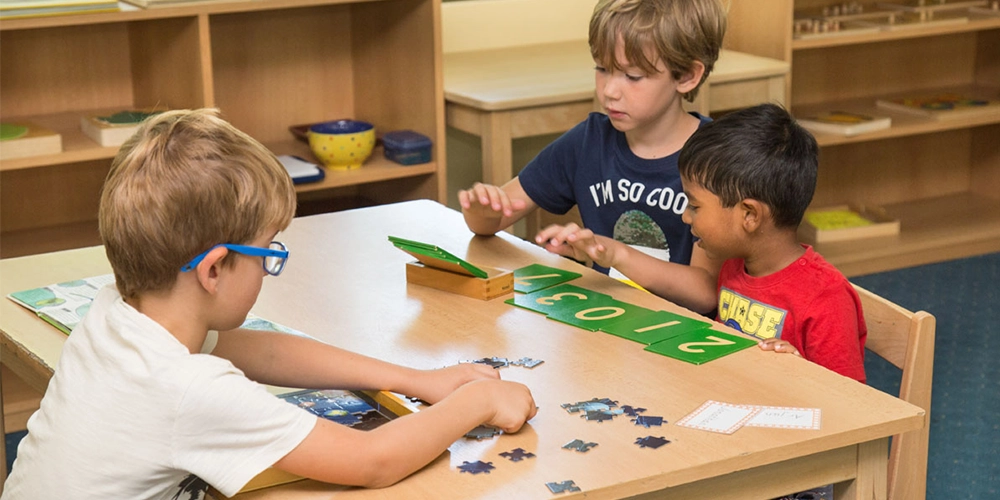
Introduction
Multi-age classrooms require more than good intentions—they demand clear structure, adaptable design, and daily flexibility. In the sections, you’ll find detailed strategies for setting up your space, choosing furniture that serves multiple age groups, and organizing learning zones that support independence and collaboration.
This is not theory. It’s a practical playbook you can use to design a classroom that’s built to grow with your students.
Understanding the Multi-Age Classroom Concept
What is a Multi-Age Classroom?
A multi-age classroom in a preschool setting brings together children from different age groups—typically two to six years old—into a shared, thoughtfully designed environment. Unlike traditional classrooms that group children by single-year age bands, multi-age classrooms prioritize where a child is developmentally, not just the number on their birthday cake.
In this space, a two-year-old might be stacking blocks nearby while a four-year-old is engaged in imaginative play, and a five-year-old helps a friend with a puzzle. The room isn’t divided by age—it’s connected by curiosity, interaction, and purposefully selected materials that support a wide range of abilities.
The result is a flexible, family-like setting where every child is a learner and a contributor. Younger children observe and learn from older peers, while older children gain confidence and leadership by supporting those just beginning.
How Multi-Age Classrooms Work in Preschool
In preschool multi-age classrooms, the teacher doesn’t stand before everyone, giving the same lesson. Instead, learning unfolds in small groups, hands-on centers, and one-on-one moments. Based on interest and readiness, children might rotate between activity zones, such as a sensory table, dramatic play corner, or quiet reading nook.
The role of the teacher is more like a facilitator or guide. They observe each child, introduce new materials at the right time, and gently support social interactions. There’s no pressure to “keep up” or “slow down.” Every child follows their own pace within a shared rhythm.
Activities are open-ended, and materials are chosen for various skill levels. For example, wooden blocks are simple enough for toddlers to explore and complex enough for older children to build detailed structures. Books, art supplies, and puzzles are made accessible and varied so each child can find something right for them.
Multi-Age vs Mixed-Age vs Traditional Preschool Classrooms
While these terms are often used interchangeably, meaningful differences exist in how each classroom type is structured and operated.
Here’s a side-by-side comparison to help clarify:
| Aspect | Multi Age Classroom | Mixed Age Classroom | Traditional Classroom |
|---|---|---|---|
| Age Grouping | Intentional grouping across 2–3 years (e.g., 3–6) | Grouped based on enrollment or staffing | Narrow age range (usually one year) |
| Philosophy | Development-based, peer learning focused | Practical or logistical grouping, not always philosophically driven | Based on standardized age-based benchmarks |
| Curriculum Design | Flexible, open-ended, individualized | Often standardized, with minor adjustments | Grade-level content, same for all |
| Teacher’s Role | Facilitator, observer, adaptive to each child | Instructor or manager of varying levels | Direct instruction, uniform teaching |
| Peer Interaction | Encouraged and structured across age lines | Unstructured age gaps may or may not be considered | Mostly among same-age peers |
| Continuity | Often multi-year (children stay with same teacher/class) | Typically single-year duration | One year, then move to new class and teacher |
| Space & Materials | Designed for a wide range of needs and abilities | May lack developmentally diverse materials | Age-specific equipment and toys |
This comparison highlights how multi-age classrooms stand out in structure, intention, flexibility, and developmental value.
Core Features of a Multi-Age Preschool Classroom
A successful multi-age classroom for preschoolers isn’t just about combining different age groups. It’s about designing a responsive, engaging environment that nurtures each child’s development through thoughtful planning.
Here are the core features that define this model—each carefully tailored to early childhood needs:
1. Mixed-Age Grouping (2–3 Year Span)
Children in a multi-age classroom typically range from two to six years old. This age span allows younger children to learn from older peers, while older children strengthen their knowledge by guiding others. This age diversity’s social and cognitive benefits are central to how the classroom functions.
2. Open-Ended, Flexible Routines
The daily schedule isn’t broken into rigid time slots. Instead, it includes large blocks of uninterrupted play, exploration, and small-group interaction. Children move between activities based on readiness and interest, not age or assigned time.
3. Peer-to-Peer Learning Opportunities
Older preschoolers often help younger classmates during clean-up, storytelling, or block building. These interactions are natural, not forced, and help both groups build empathy, communication, and confidence. Peer modeling replaces top-down instruction in many moments.
4. Differentiated Materials & Multi-Level Tools
A well-stocked multi-age classroom includes toys, books, puzzles, and art supplies for various developmental stages. For example, a single shelf might hold large knobbed puzzles for toddlers and more complex interlocking ones for older kids. No child is left out because the materials are too simple or advanced.
5. Long-Term Relationships & Teacher Continuity
Children often remain with the same teacher or teaching team for over a year. This extended time frame helps educators better understand each child’s strengths, challenges, and learning style. The classroom becomes a stable, predictable space, key to young children’s emotional development.
6. Respect for Individual Pace
Progress isn’t measured against other children but against each child’s growth. There are no “late bloomers” here—only children learning in their own way, on their own timeline. This approach reduces anxiety and fosters intrinsic motivation.
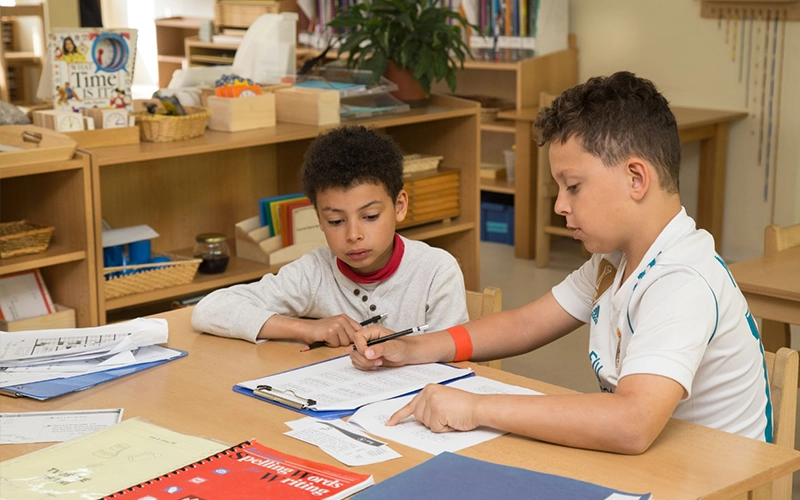
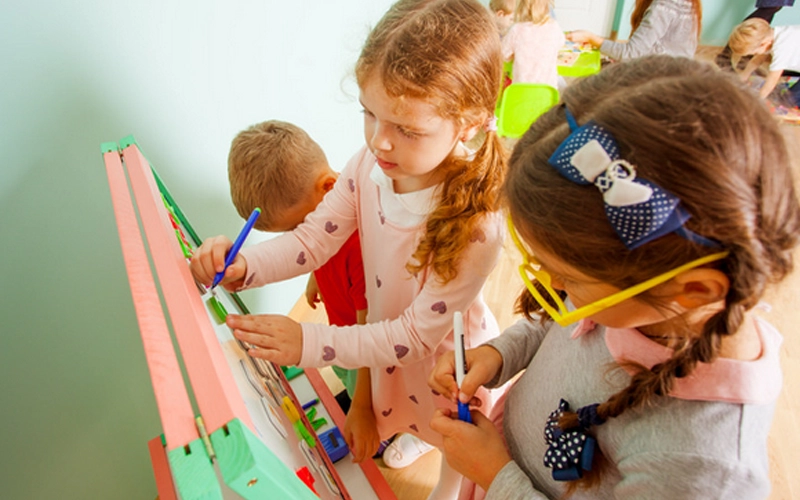

Pedagogical Foundation and Global Trends
The Educational Philosophy Behind Multi-Age Classrooms
The multi-age classroom model is grounded in the belief that children learn best in environments that reflect the real world, where people of different ages learn, work, and grow together. This approach shifts the focus from age-based instruction to developmentally appropriate practice.
Instead of expecting every child to meet the same milestones simultaneously, multi-age classrooms honor individual readiness. Children are not rushed to catch up or held back to wait for others. They learn by doing, observing, exploring, and interacting with adults, materials, and, most importantly, each other.
This structure supports a variety of learning styles and allows educators to meet children where they are. It also promotes a more profound sense of community, as older children naturally take on leadership roles and younger children are inspired by what they see their peers doing.
Montessori and the Multi-Age Approach
The Montessori approach is one of the most structured and widely studied examples of multi-age learning in early childhood. It doesn’t just allow mixed-age groupings—it depends on them. Montessori classrooms are intentionally designed to span three-year age ranges, most commonly 3–6 years, which aligns perfectly with the preschool phase.
In a Montessori multi-age classroom, children choose their activities from a carefully curated set of materials. These materials are arranged on open shelves, within easy reach, and are self-correcting, meaning children can use them independently without constant adult intervention. This design encourages autonomy, exploration, and self-paced growth.
The thoughtful use of the environment makes the Montessori model powerful for multi-age settings. Classroom areas are divided into practical life, sensorial exploration, math, language, and cultural activities. These zones are accessible to all ages, but children engage with them differently depending on their stage of development. For example, a younger child may explore pouring with beans and scoops, while an older peer works on measuring liquids using the same type of material.
Teachers in a Montessori setting act more as guides than instructors. They observe each child’s interests and developmental needs closely, stepping in only when necessary. They introduce materials when the child shows readiness, not because it’s scheduled. Peer learning is also central: older children naturally model behavior, routines, and problem-solving without being prompted.
This model supports multi-age classrooms in a way that’s deeply aligned with preschool goals. It recognizes that children grow in waves—not steps—and that having younger and older learners in the same space creates more chances for growth, not more complications.
The Montessori multi-age approach promotes order, independence, and social learning and provides a clear framework for designing classrooms that support real development, not just academic readiness.
Why This Model Works for Preschoolers
Preschoolers learn by doing, watching, touching, and repeating. They’re wired for hands-on experiences and social interactions, not passive instruction. That’s precisely why the multi-age classroom works so well at this stage of development.
One day, you might see a younger child quietly watching how an older peer uses a pair of tongs to sort colored pom-poms into cups. Ten minutes later, that same younger child tries it independently, building fine motor skills without realizing it. In another corner, two older preschoolers might negotiate who becomes the “chef” in the pretend kitchen—a natural opportunity to develop language, patience, and turn-taking.
These real-time, mixed-age interactions are powerful. Younger children learn through imitation, and older children grow through leadership. Both groups benefit from being part of a room that values their stage, not just their age.
From a teacher’s perspective, a multi-age classroom also supports behavior management. Children who’ve been in the class longer understand the routines and help model expectations. This peer consistency reduces teachers’ time managing transitions or repeating instructions. Instead, the class culture becomes embedded, making it easier for newcomers to adapt and for returning students to deepen their independence.
Emotionally, multi-age settings also tend to be more nurturing. With less comparison and competition, children feel safe taking risks, trying new tasks, and asking for help. The environment is less about who’s ahead and more about how we grow together.
For preschoolers developing their identities, social skills, and self-regulation, this space offers the flexibility and emotional safety they need most. It helps them build a foundation for personal and shared learning at their own pace, surrounded by peers who are both similar and different.
The Global Rise of Multi-Age Preschool Classrooms
Although the multi-age classroom model is often associated with Montessori education, it is widely adopted in many early learning settings.
In preschools and daycares across North America, Europe, and Asia, educators are exploring mixed-age grouping as a solution to:
- Inconsistent enrollment numbers
- Diverse readiness levels among same-age children
- The need for stronger peer learning and community bonding
Programs inspired by Reggio Emilia, forest schools, and inquiry-based learning also incorporate age flexibility as part of their core design. These approaches recognize that learning doesn’t always follow a straight, linear path, and that classrooms should reflect that.
Whether driven by philosophy or practicality, the move toward multi-age grouping is growing. It offers a way to create more inclusive, adaptable classrooms that can meet the changing needs of today’s early childhood kids.
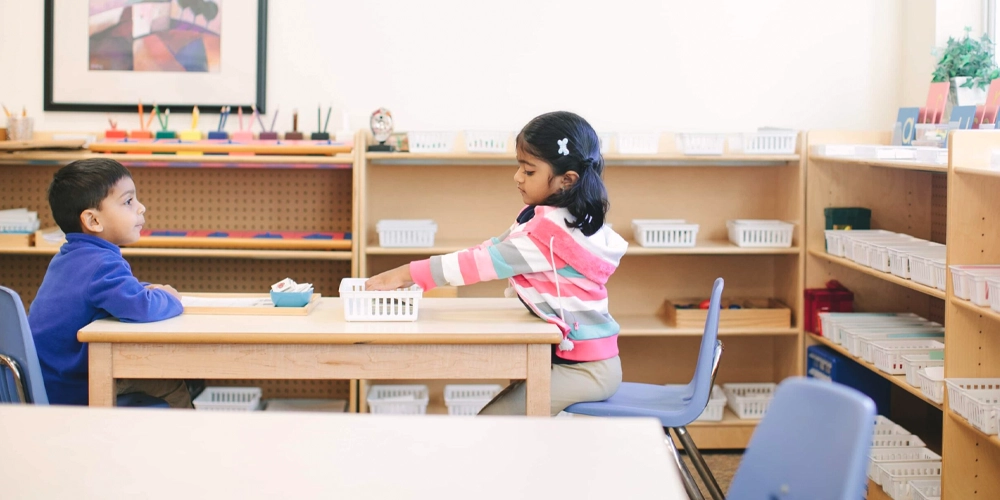
Core Benefits & Challenges of Multi-Age Classrooms
Advantages of Multi-Age Classrooms
The multi-age classroom offers several unique advantages that align closely with preschoolers’ developmental needs. These benefits extend to children, teachers, and even families.
- 1. Peer Learning and Leadership
In a mixed-age setting, children naturally learn from one another. Younger children observe how older peers use materials, speak to teachers, solve problems, and follow routines. This exposure helps them advance their skills faster than in age-isolated classrooms.
At the same time, older children gain confidence and maturity by helping younger classmates. This builds leadership, empathy, and patience—skills that serve them well in later academic and social environments. - 2. Individualized Learning Pace
Children develop at different speeds, especially during the preschool years. In a multi-age classroom, there’s less pressure to “catch up” or “slow down.” Teachers observe and support each child based on where they are, not where the curriculum says they should be.
This model allows for natural progression in language, motor skills, and social development, making room for both early bloomers and late starters. - 3. Stronger Classroom Community
Because students often stay in the same classroom for multiple years, they develop a deep sense of belonging. Familiarity with peers, routines, and the physical space creates emotional security.
This sense of continuity benefits children who may struggle with transitions. It also helps teachers form stronger, more informed relationships with families over time. - 4. More Dynamic, Engaging Environment
Multi-age classrooms tend to be more flexible and creative. Activities can be designed to include multiple levels of difficulty. For example, younger children might focus on color and texture during an art project, while older ones explore patterns or storytelling.
This multi-layered approach makes learning more engaging and accessible to everyone.
Disadvantages of a Multi-Age Classroom
While the multi-age model offers many strengths, it also presents challenges that teachers and administrators must be prepared to address.
- 1. Teacher Preparation and Training
It takes skill and experience to manage a classroom with such a wide developmental range. Teachers must be able to observe, assess, and adjust in real time. This level of responsive teaching often requires additional training, especially for those new to early childhood education. - 2. Curriculum Planning Can Be Complex
Creating lesson plans that work for multiple age groups is more demanding. Activities must be adaptable, and learning materials must support various skills. Without proper planning, some children might become bored while others feel overwhelmed. - 3. Balancing Group Dynamics
Children of different ages have different attention spans, interests, and energy levels. It can be challenging to maintain classroom harmony when one group wants to build with blocks while another is focused on storytelling or quiet play.
Without clear zoning, the space can become chaotic. Teachers need strong classroom management and thoughtful layout strategies to keep activities flowing smoothly.
Pros and Cons Summary Table
Here’s a quick look at the main strengths and potential drawbacks of multi-age classrooms in preschool:
| Aspect | Advantages | Disadvantages |
|---|---|---|
| Peer Interaction | Encourages mentorship, leadership, and empathy | Older children may dominate without guidance |
| Learning Pace | Supports individualized progress | Requires flexible curriculum design |
| Social Environment | Builds community and long-term friendships | Social maturity gaps may need extra teacher attention |
| Teaching Approach | Enables observation-based, responsive teaching | Harder to standardize assessments and outcomes |
| Classroom Culture | Promotes cooperation over competition | Harder to standardize assessment and outcomes |
| Materials & Layout | Multi-use materials foster creative use across ages | Space needs more organization to avoid overstimulation |
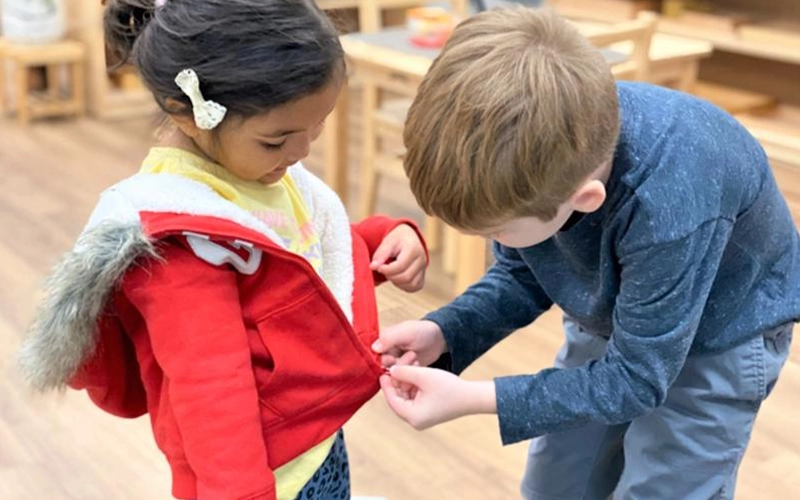
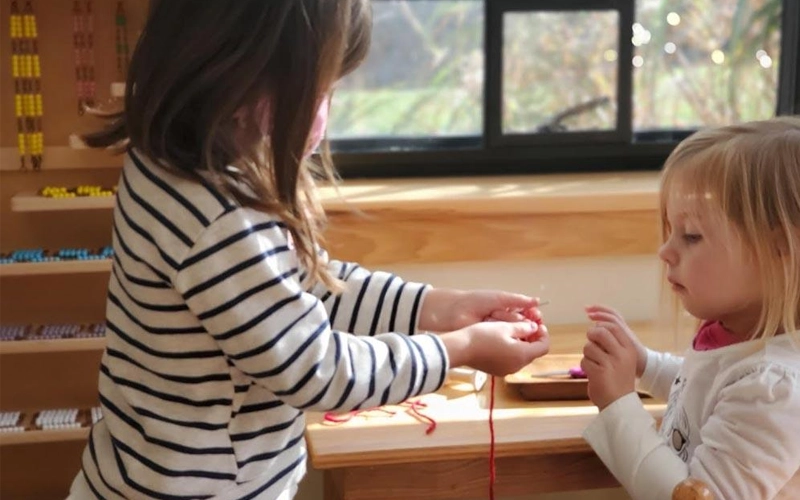
Operationalizing Multi-Age Classrooms in Preschool & Daycare
Flexible Daily Rhythms that Work for Everyone
In a multi-age preschool classroom, rigid time blocks and subject-specific schedules don’t make sense. Instead, what works best is a rhythm-based structure—predictable routines that give all children a sense of stability, while allowing for flexibility based on age, energy levels, and individual needs.
Rather than all children doing the same activity simultaneously, the day is broken into shared moments (like circle time or outdoor play) and open-ended periods where children move between activity zones at their own pace. This rhythm supports children in developing independence, reduces transitions, and allows teachers to offer more personalized guidance.
For example, during open-ended center time, a 2.5-year-old might explore scooping and pouring in the sensory bin, while a 4.5-year-old writes their name using magnetic letters on a nearby table. Both are learning at different levels and in the same space.
Managing Diverse Developmental Needs Through Structure
One of the most essential elements of a successful multi-age classroom setup is how it handles varying stages of development. In traditional classrooms, children are grouped by age, which can mask individual readiness. The differences are more visible in mixed-age settings, but so are the opportunities.
To support all learners:
- Classroom zones are intentionally designed—rather than age-based separation, the space is organized by activity type (quiet reading, dramatic play, building, etc.).
- Materials are tiered in complexity, so younger children can explore safely while older children are challenged. For example, block corners may have large foam blocks for toddlers and intricate building sets for older preschoolers.
- Behavior modeling happens naturally—younger children observe routines and habits from peers, while older children build leadership and patience by helping others.
- Small-group instruction is flexible, often based on skill readiness rather than age. During art time, some children might be learning to hold a brush, while others create multi-step collages—all in the same environment, guided by the same teacher.
This approach nurtures inclusivity and encourages real-life social learning: learning how to take turns, solve minor conflicts, and respect differences in ability and behavior.
The Teacher’s Role: Guide, Observer, and Facilitator
In multi-age preschool classrooms, teachers play a dynamic and multifaceted role. Their responsibilities go far beyond instruction—they constantly observe, adjust, and support a group with varied needs.
Here’s how teachers make it work:
- Observation and documentation are central. Teachers use what they see—not just what a curriculum says—to guide each child’s learning path.
- Responsive interaction is key. A teacher might pause a group activity to help a younger child regulate their emotions or quietly encourage an older child to mentor a peer during a task.
- Encouraging independence is a daily goal. From choosing activities to cleaning up materials, every task is an opportunity for self-directed learning.
- Maintaining continuity across years builds trust. Because many children stay with the same teacher for 2–3 years, the teacher-child relationship deepens, allowing for better understanding and more tailored support.
This kind of teaching isn’t about managing a classroom—it’s about managing relationships, rhythms, and readiness levels within the same space.
How to Design Early Learning Spaces for Mixed‑Age Groups
Flexible Furniture That Supports Developmental Differences
In a multi-age preschool classroom, furniture isn’t just about size but function, adaptability, and inclusion. The right furniture helps manage a room full of diverse needs without making any child feel left out or misplaced.
1. Adjustable & Modular Tables and Chairs
Children aged 2.5 to 5 can differ dramatically in height, posture, and interaction with materials. Instead of buying separate sets of furniture for different age groups, look for adjustable-height tables and stackable chairs that accommodate multiple stages of growth.
Modular tables can also:
- Be grouped for collaborative work
- Separated for quiet solo activities
- Easily moved to open up floor space for gross motor activities or circle time
This adaptability supports development and simplifies classroom transitions throughout the day.
2. Shared Work Surfaces at Varied Levels
A mixed-age room should offer multiple table heights:
- Low tables for floor-seated play or toddlers working on puzzles
- Standard-height workstations for older children doing writing or fine motor activities
- Standing-height surfaces for messy art or hands-on science tasks
This approach provides physical comfort and developmental alignment without segregating age groups.
3. Storage that Teaches Responsibility
Furniture also includes storage systems, and in multi-age classrooms, the design of these systems must be both accessible and instructive.
- Open shelves at low and mid-level heights allow children to select and return items independently.
- Visual labels (icons + words) reinforce early literacy while helping with organization.
- Mobile carts encourage flexible use of materials across zones
Well-placed storage supports classroom flow, teaches responsibility, and reduces clutter-related stress for children and teachers.
4. Safety First, Always
Safety considerations in mixed-age groups are non-negotiable. Furniture should be:
- Rounded at edges
- Stable and tip-proof
- Made of non-toxic materials
- Able to handle intensive daily use
Look for certified preschool-grade furniture explicitly designed for daycare and early learning centers.
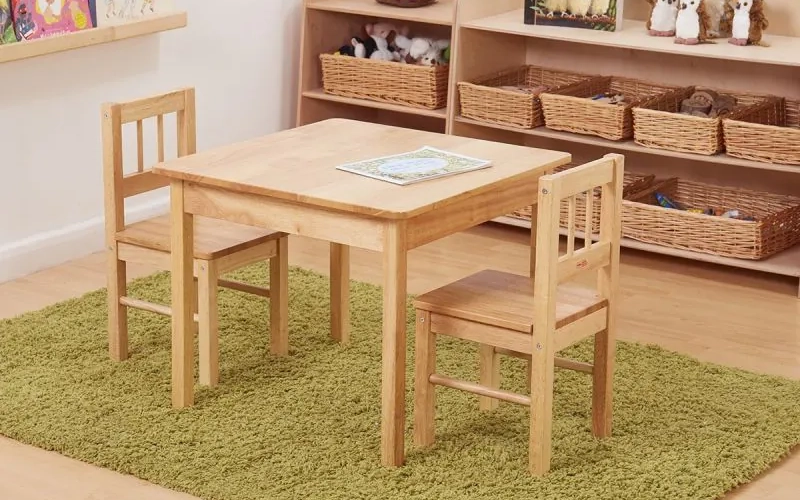
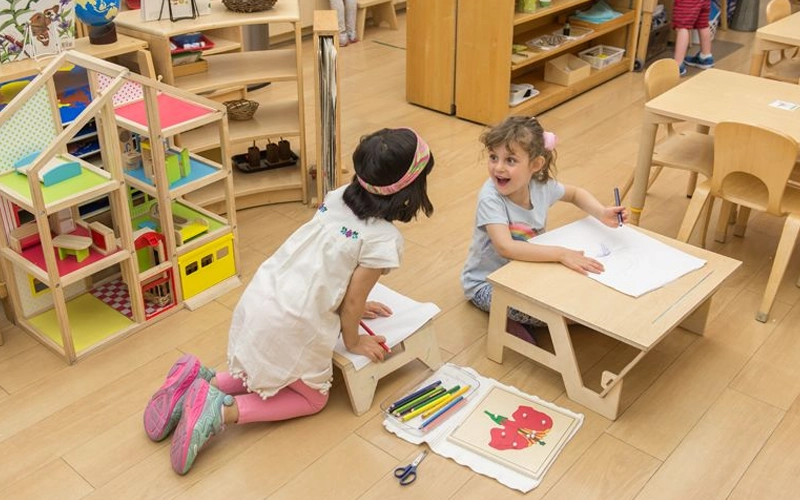
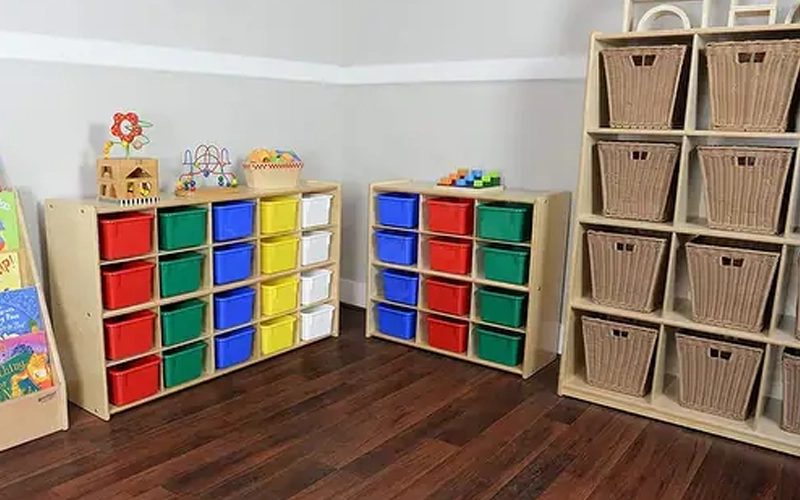
Smart Storage Solutions for Multi-Age Classrooms
In a well-functioning multi-age preschool classroom, storage is not just about keeping things tidy—it’s about supporting independence, organization, and smooth transitions for children across various abilities. How materials are stored determines whether children can access what they need, put things away independently, and move confidently through the day.
Here are the most effective storage strategies for mixed-age early learning environments:
1. Layered Accessibility for All Ages
Children aged 2 to 5 have vastly different heights and coordination levels. That’s why adequate storage combines multiple height levels:
- Lower shelves (under 60 cm) for toddlers to easily reach toys, books, and sensory materials
- Mid-height shelves for older preschoolers to access more complex games or materials with smaller pieces
- Top-level storage (teacher-managed) for items requiring supervision, such as scissors, paint, or STEM kits
This setup ensures that no child is left out due to physical limitations while promoting age-appropriate responsibility.
2. Open, Visible, and Clearly Labeled
When children can see materials, they’re more likely to use them and return them properly. Use:
- Clear plastic bins for art supplies, manipulative toys, and puzzle sets
- Picture labels with text to promote early literacy and recognition
- Color-coded zones or shelf labels (e.g., green for blocks, blue for reading, yellow for art) to create a mental map of the room
These systems help children develop executive function skills like categorizing, sorting, and remembering routines.
3. Mobile & Modular Storage
Classrooms with multi-age setups benefit greatly from movable furniture. Mobile carts and rolling shelves allow teachers to:
- Bring the materials closer to the younger children
- Quickly reconfigure the classroom for group work, floor play, or clean-up
- Adapt storage positions as the group evolves across months or years
This flexibility level is essential when children share classrooms at different readiness levels.
4. Storage as a Learning Tool
Great classroom storage doesn’t just manage materials—it teaches children how to manage their own space. Teachers can integrate simple routines like:
- Daily “clean-up songs” to signal organization time
- Peer helpers who assist others in returning materials
- Weekly “shelf inspections” where children assess whether things are in the right place
Over time, these routines nurture independence and respect for the shared environment, which is especially critical in multi-age classrooms.
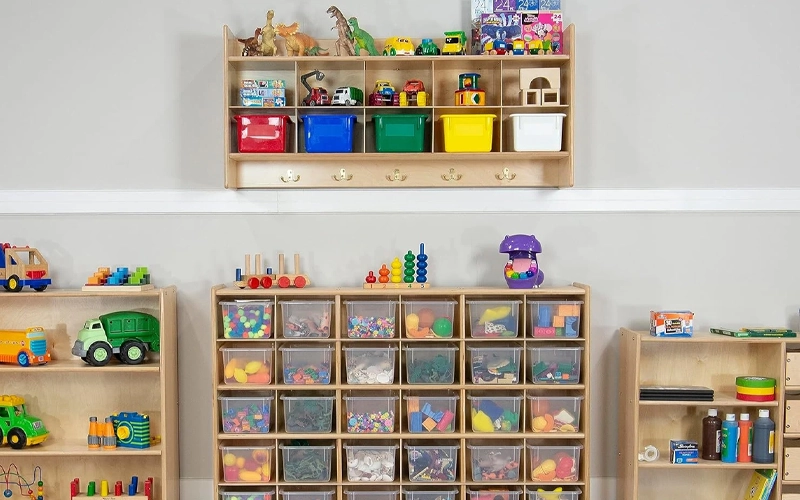

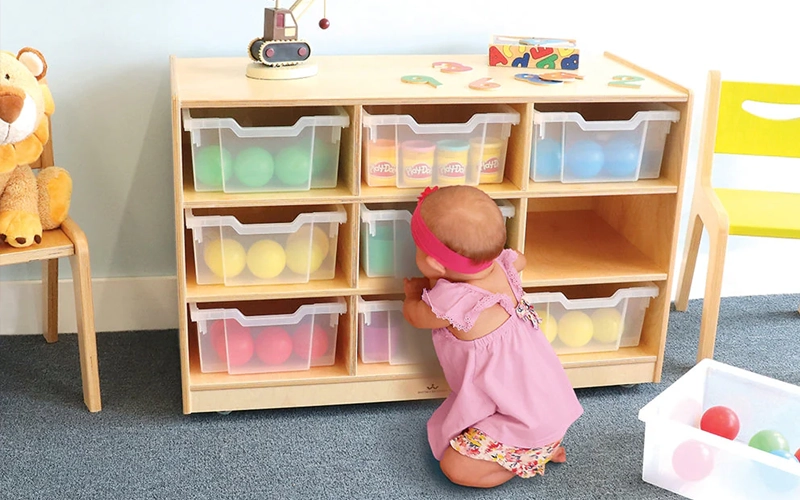
Your perfect classroom is one click away!
Zoning the Room for Inclusive Play and Learning
Zoning is the backbone of classroom management in a multi-age preschool environment. With children at different developmental stages sharing the same space, a well-zoned room provides structure and freedom. It reduces overstimulation, supports self-regulation, and ensures that every child—regardless of age—can engage meaningfully in their learning journey.
Here’s how to create zones that support inclusivity, independence, and interaction.
1. Quiet Zones for Focus and Self-Regulation
A quiet zone serves as a calm refuge for children who need a break from social or sensory stimulation. This area is critical in multi-age classrooms, where younger children may become overwhelmed, and older children may seek solitude to concentrate.
Key elements:
- Soft seating: beanbags, floor cushions, or small couches
- Visual barriers, like shelves or fabric dividers, can reduce distractions
- Calming visuals: nature posters, soft lighting, or pastel color palettes
- A variety of materials: board books, fidget tools, sensory bottles
Quiet zones teach children to recognize their emotions and manage their needs independently.
2. Gross Motor & Movement Zones
Preschoolers have a natural drive to move. A designated movement zone supports this need, especially when age-based energy levels vary.
Suggestions:
- Indoor climbing structures or balance beams (foam-based and low-rise)
- Floor mats for stretching or dancing
- Wall panels with Velcro shapes or movable parts
This zone supports physical development and helps redirect excess energy in a safe, structured way.
3. Open-Ended Play Zones
Open-ended play is the foundation of early learning, and zoning supports different skill levels without separating children. These zones include:
- Construction zone: with large foam blocks for toddlers and LEGO/DUPLO for older preschoolers
- Dramatic play area: dress-up clothes, play kitchens, and real-life props like telephones, stethoscopes, or shopping carts
- Sensory stations: sand, water, rice bins with measuring cups and scoops
Each child engages with the same materials in developmentally appropriate ways, allowing peer modeling and parallel play to occur naturally.
4. Reading and Literacy Zones
This area encourages early language development and fosters a love of books for all ages.
Zone essentials:
- Board books for toddlers, picture books for preschoolers, and simple early readers
- Low, front-facing bookshelves
- Puppets, felt boards, and alphabet puzzles
- Listening station with audio stories and headphones (for older children)
Placing literacy-rich elements across zones also reinforces reading as a part of all learning, not just in the book corner.
5. Creative Arts Zone
The creative arts zone must be inclusive of all fine motor levels:
- Crayons, thick markers, and paint sticks for toddlers
- Scissors, glue, and stencils for older children
- Easels and table-level trays so multiple children can work simultaneously
Keep smocks, wipes, and clean-up bins nearby so children learn how to care for materials regardless of their age.
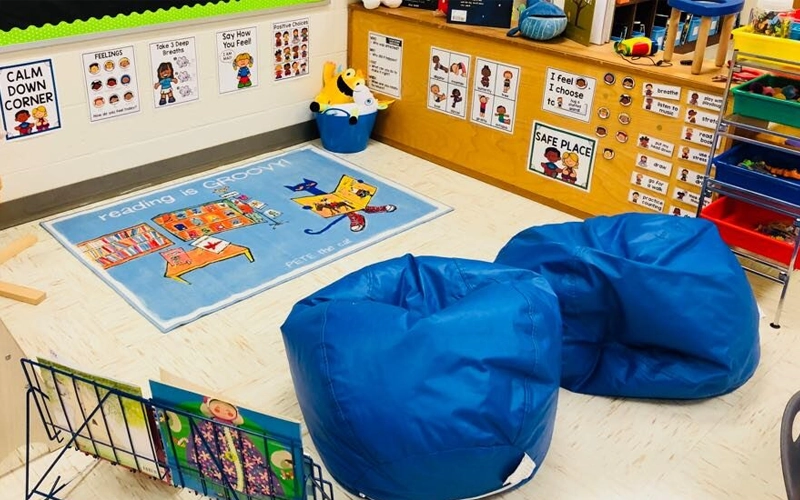
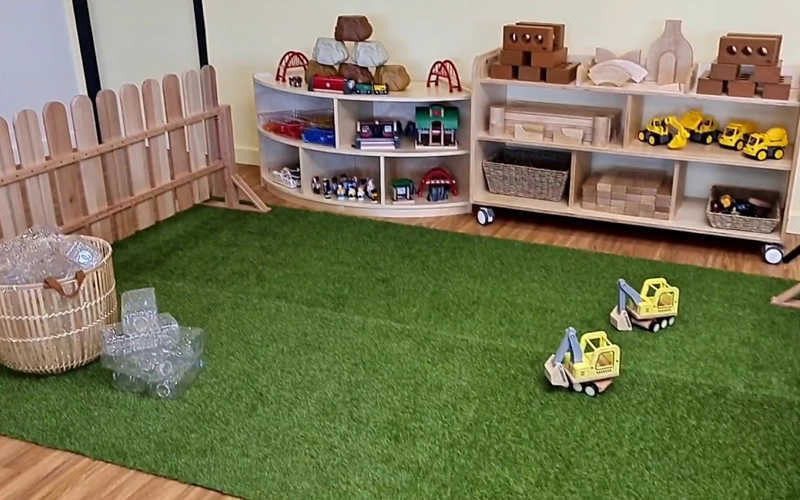

Don’t just dream it, design it! Let’s chat about your custom furniture needs!
Material Selection Across Ages
Choosing materials for a multi-age classroom is a balancing act. The same space must serve a child learning to stack blocks and another beginning to count, read, or construct complex ideas. The key is to choose open-ended materials, tiered in complexity, and safe for all age groups.
Done right, material selection supports differentiated learning without segregating children.
1. Open-Ended Toys That Scale with Age
Open-ended toys are a must-have in mixed-age preschool classrooms. These are materials with no fixed outcome, allowing children to use them in ways that reflect their stage of development.
Top examples include:
- Blocks: Toddlers stack for stability, while older preschoolers create imaginative buildings and structures.
- Magnetic tiles: Young children explore color and shape, older children build cars, animals, or geometric patterns.
- Play-dough and loose parts: Used for squeezing and shaping by younger kids, and for storytelling, modeling, or pattern-making by older ones.
With these materials, play naturally becomes differentiated without needing separate toys.
2. Books That Reflect Multiple Reading Stages
A well-stocked book area offers variety in both reading level and content:
- Board books with simple images for toddlers
- Storybooks with basic plots and repetitive phrases for early learners
- Books with more detailed illustrations and narratives for advanced preschoolers
Adding tactile books, story baskets, or storytelling props allows non-readers to engage deeply with stories.
3. Tiered Learning Tools for Literacy & Math
In multi-age preschool classrooms, the goal is to offer varied entry points into key skill areas:
- Literacy tools:
- Alphabet blocks for recognition
- Name tags and word walls for early readers
- Magnetic letters and word-building kits for older preschoolers
- Math materials:
- Counting bears or bead strings for number sense
- Simple board games to teach sequencing and quantity
- Pattern cards and measuring tools for early STEM
Teachers can set up the same center with tools for multiple skill levels—children self-select based on readiness.
4. Safe, Supervised Complexity
Some materials—like scissors, mini puzzles, or fine motor kits—require supervision. In mixed-age classrooms:
- These items are placed on higher shelves or stored in teacher-led areas
- Access is granted based on a child’s readiness and familiarity with the tool
- Teachers model and guide usage, creating learning opportunities and trust
This helps maintain safety without excluding capable children from challenging tasks.
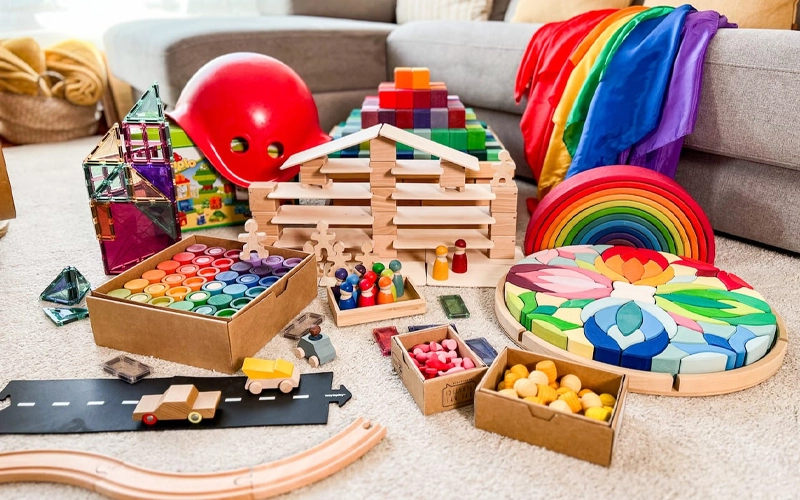


Lighting, Acoustics, and Emotional Tone
The environment of a multi-age preschool classroom doesn’t stop at furniture and materials. Lighting, sound, and overall atmosphere significantly influence children’s emotions, energy levels, and behavior. In classrooms where children of varying developmental stages learn together, these sensory elements must be more intentionally planned to create comfort and coherence.
1. Natural Light Supports Mood and Attention
Daylight exposure improves mood, focus, and sleep patterns, which is significant for preschoolers whose bodies are still building their circadian rhythms.
- Prioritize large windows and unobstructed natural light where possible.
- Use sheer curtains to diffuse glare without blocking brightness.
- If natural light is limited, invest in full-spectrum LED lighting that mimics daylight and reduces strain.
Organize high-focus areas (like reading or project tables) near windows to take advantage of calm-inducing natural illumination.
2. Layered Lighting for Diverse Activities
Because multi-age classrooms are multi-functional, flexible lighting is essential:
- Use dimmable overhead lights to transition between active play and quiet time.
- Install task lights or low table lamps in quiet zones and reading corners for a cozy, focused vibe.
- Use accent lighting to highlight displays or materials, creating visual interest without overstimulation.
Different lighting levels help children associate specific spaces with certain behaviors, such as being calm, focused, energetic, or social.
3. Acoustic Design for Focus and Harmony
Young children are sensitive to noise. Without acoustic planning, a mixed-age classroom can become chaotic fast.
Strategies include:
- Soft materials (rugs, curtains, padded furniture) to absorb sound
- Cork or felt wall panels to reduce echo
- Acoustic ceiling tiles in large rooms
- Use white noise machines or gentle background music to mask disruptive sounds during transitions.
Use furniture to help define sound zones—quiet areas for reading, louder areas for dramatic play. This teaches children to self-regulate based on the expectations of each zone.
4. Color Psychology and Visual Cues
Colors affect emotions. While vibrant hues stimulate energy, they can also overwhelm younger children or distract those who need calm.
In multi-age classrooms:
- Use neutral or soft earth tones for walls and large furniture to create a grounded, peaceful backdrop.
- Add pops of color in learning zones (e.g., a bright blue rug in the block area) to define space and spark interest.
- Avoid overstimulation—limit busy patterns, visual clutter, or excessive wall décor.
- Use symbolic cues, such as footprints on the floor, for movement paths or soft frames to highlight key displays visually.
The goal is to help children understand space visually without needing verbal explanation—a beneficial strategy for toddlers or ESL learners.
Balancing Safety and Creativity in Multi-Age Classrooms
Designing a multi-age preschool classroom means walking a fine line between encouraging exploration and ensuring safety. With toddlers and older children sharing the same environment, every corner must invite creativity without compromising well-being.
1. Age-Appropriate Safety Standards
Younger children are more vulnerable to hazards like small objects, unstable furniture, or high surfaces. In multi-age preschool classrooms, safety must be layered:
- Use only non-toxic, rounded-edge furniture
- Ensure shelving is anchored to walls and doesn’t tip easily
- Avoid small manipulatives in areas accessible to toddlers
- Offer age-specific zones for higher-risk materials like scissors or glue guns, supervised by a teacher
Designing for safety doesn’t mean removing challenge—it means managing risk to promote trust, responsibility, and autonomy.
2. Encouraging Risk-Taking Through Safe Exploration
Creativity and innovation grow when children feel free to experiment. In mixed-age classrooms, this might look like:
- Older children build tall block towers, while toddlers explore balance with smaller foam shapes
- A messy art zone where younger kids finger-paint, and older ones work on detailed collages
- Nature-based materials like sticks, rocks, and leaves are used differently by people of different ages
Providing structured freedom gives children the confidence to explore without fear—an essential ingredient in early childhood development.
3. Teaching Safe Peer Interaction
Safety also includes how children interact with one another. Mixed-age classrooms need clear rules for:
- Sharing tools and materials fairly
- Respecting personal space during high-energy play
- Helping without dominating—older children may want to “do for” rather than “help with”
Teachers model these behaviors and guide when needed, creating a culture of empathy and responsibility across age lines.
4. Rotating Materials with Development in Mind
What’s safe and stimulating for one group may not suit another. Teachers should rotate materials regularly based on:
- Observed behavior: e.g., if toddlers keep mouthing pieces, remove or replace them
- Skill progression: When older kids outgrow certain puzzles, introduce more advanced ones
- Seasonal themes or project work: align materials with current interests while maintaining safety
Rotation keeps children engaged and ensures the classroom grows with them, without compromising structure or order.
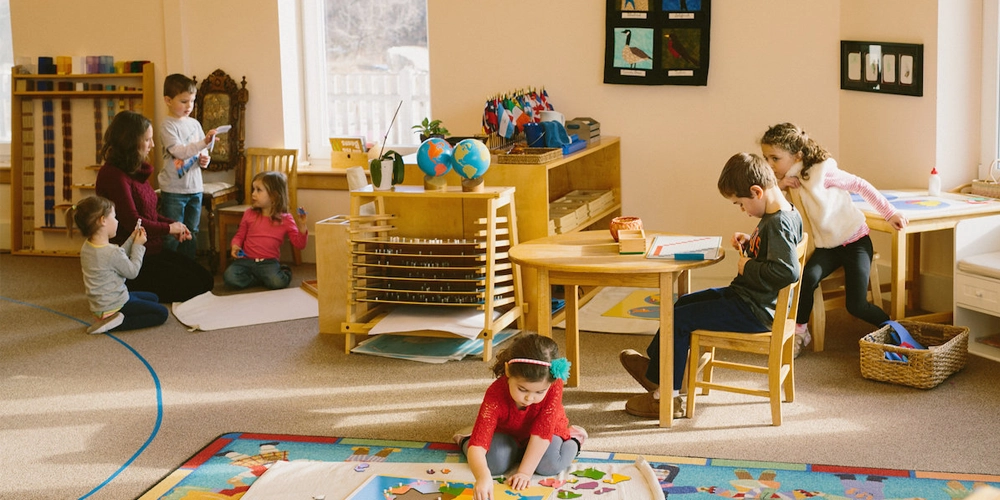
Bridging Vision and Execution in Multi-Age Classroom Design
Designing a multi-age classroom begins with principles—zoning, flow, and emotional tone—but bringing these ideas to life requires practical, hands-on solutions. Once the vision is clear, it’s time to focus on the tools, materials, and layout features that make day-to-day learning seamless and scalable across age groups.
In the following section, we move from planning frameworks to implementation strategies, sharing specific furniture choices, storage tactics, and design enhancements that support real-world preschool classrooms. Whether you’re starting fresh or upgrading an existing mixed-age space, these practical tips will help transform theory into function while ensuring flexibility, safety, and child-led learning remain at the center.
Practical Solutions to Bring Your Multi-Age Classroom to Life
Flexible Furniture That Grows with Children
In a multi-age preschool classroom, furniture must adapt to the growing bodies and evolving skills of children aged 2.5 to 5. Here’s how to build in flexibility:
- Adjustable tables and chairs that can be raised or lowered as children grow, ensuring comfort and correct posture over the years.
- Stackable, lightweight chairs that are easy for little hands to move, yet sturdy enough for older preschoolers.
- Convertible workstations: tables that join for collaborative tasks but separate for quiet solo or small-group work.
- Mobile units with locking wheels allow the classroom layout to be reconfigured throughout the year, promoting diverse activities.
- Long-lasting, preschool-grade materials with rounded corners and durable surfaces that can withstand years of use.
This flexible setup reduces the need for frequent furniture replacement and supports ergonomic, age-appropriate use throughout the classroom lifecycle.
Storage and Layout Tools That Support Mixed‑Age Needs
Adequate storage helps children of all ages access materials independently and understand expectations. Use these tools to keep the classroom organized and empowering:
- Multi-height shelving: low shelves (<60 cm) for toddlers and mid-level shelves for older preschoolers.
- Transparent and open bins so children can visually identify what’s inside—no reading required.
- Visual, icon-based labels plus simple words to boost early literacy while helping children find and return materials.
- Mobile storage carts for materials like manipulatives or art tools—easily moved to different learning zones.
- Structured “storage routines”, such as daily clean-up songs and peer helpers, foster organizational skills and classroom ownership.
These tools promote independence, streamline clean-up, and help maintain a layered environment suited to various developmental stages.
Design Enhancements to Improve Mood, Safety, and Flow
To create a space that truly supports shared learning, focus on these environmental upgrades:
- Defined pathways using rugs or floor tape to guide movement and reduce collision points during transitions.
- Mood lighting: dimmable fixtures combined with full-spectrum LED to adapt to activity type—social play, focused work, or calm reflection.
- Acoustic balance: area rugs, sound-absorbing panels, and soft seating help manage noise without isolating communication.
- Color zoning: neutral walls with intentional pops of color in distinct zones—for example, blue around the reading area, green near sensory supplies.
- Safety flow design: Rounded furniture edges, wall-anchored shelves, and clear sightlines enable supervision and reduce accidents.
By balancing aesthetics, emotional tone, and physical safety, these enhancements create a cohesive and supportive environment for mixed-age learning.
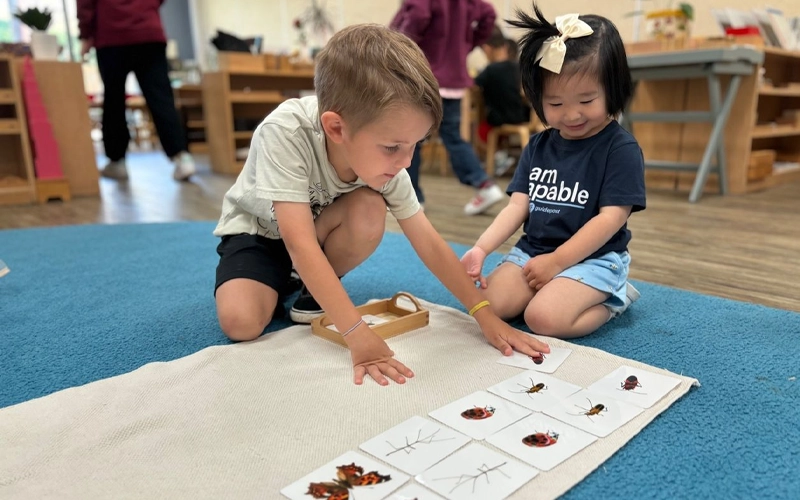

Conclusion
Designing and managing a multi-age classroom for preschool learners isn’t just a trend—it’s a powerful educational philosophy that, when executed well, nurtures leadership, empathy, and individualized learning in every child. By understanding the core values behind multi-age preschool classrooms, embracing their benefits, and proactively addressing their challenges, educators and school leaders can create developmentally responsive and emotionally supportive spaces.
From choosing flexible furniture that grows with children to applying strategic storage solutions and refining environmental details like lighting, sound, and color, every element contributes to a space where children of different ages can thrive side by side. These classrooms don’t just work—they build community, encourage mentorship, and mirror the diverse, intergenerational world children will one day lead.
Whether designing a new center or improving an existing one, the journey toward a truly functional and inspiring mixed-age classroom begins with thoughtful planning and practical choices. Every decision—from shelf height to zone layout—is an opportunity to foster independence, curiosity, and collaboration.
By following the practical solutions and principles shared in this guide, you’re not just managing age diversity but leveraging it to transform early learning into something richer, deeper, and more human.
FAQs
1. What is a multi‑age classroom in preschool?
A multi‑age classroom features children spanning a 2–3 year age range (e.g., aged 2–5), intentionally grouped to foster peer learning and developmentally appropriate progression.
2. Why choose mixed‑age groups for preschoolers?
Mixed‑age settings help younger children learn through observation, and give older children leadership roles that reinforce confidence and empathy.
3. Will older children be bored when grouped with younger ones?
Not at all. Classrooms are designed with tiered materials and stations—older children work at their level while younger ones engage in simpler versions. This structure supports differentiated enrichment.
4. How are children grouped in a multi‑age setup?
Children are flexibly grouped by developmental readiness, shared interests, or skill levels, not strictly by age. This optimizes engagement and an appropriate challenge for each child.
5. How does multi‑age grouping affect the classroom environment?
Research shows it creates a more inclusive, less competitive atmosphere. Children form mentorship bonds, self-esteem improves, and emotional well-being strengthens due to reduced peer comparison.
6. Do teacher qualifications need to change?
Yes. To effectively handle diverse developmental needs, educators must be skilled in observational assessment, responsive differentiation, and behavior management.
7. How long do children stay in a multi‑age preschool classroom?
Most programs use 2–3 year loops, where children remain with the same teacher and peer cohort, promoting stability and relational depth.
8. Are there any parental concerns?
Common concerns involve whether younger kids will keep up or if older ones will be challenged. These can be addressed by explaining how materials, peer mentorship, and teacher support balance those developmental differences.
9. Is academic progress affected compared to traditional classrooms?
Studies indicate children in mixed-age classrooms perform as well or better academically. The model supports differentiation, peer teaching, and self-paced development.



